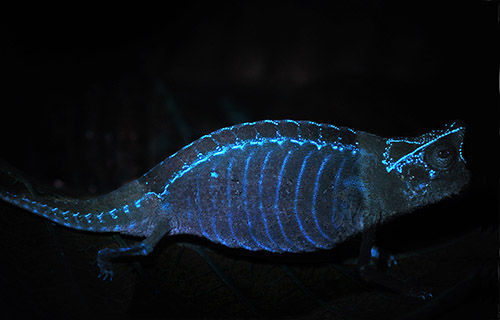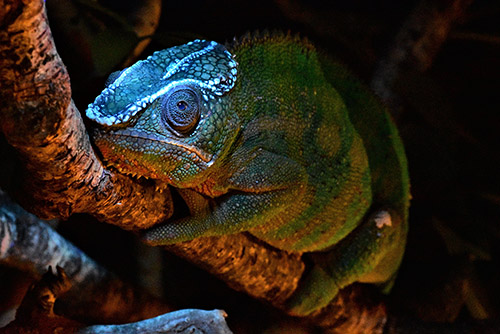Luminescent lizards – Bone-based fluorescence in chameleons
Bavarian State Collection for Zoology
Chameleons are famous for their colour language. Using colour changes and colourful patterns they communicate with their conspecifics. A research team from Munich, Germany, has now found that many chameleons have bony tubercles on their head, which glow blue under UV light and form impressive patterns. The skin in this area is very thin and transparent, so that UV light passes through a ‘window’ directly onto the bone and is converted there into visible, blue light. The function of this fluorescence is still unclear, but the researchers suspect that they are private signals for species recognition. The work was published today in the journal Scientific Reports.
Biogenic fluorescence is mainly known from marine organisms, but is rare in terrestrial vertebrates. “So we could hardly be-lieve it when we illuminated the chameleons in our collection with a UV lamp, and almost all species showed blue, previously invisible patterns on the head, some even over the whole body”, says David Prötzel, lead author of the new study and PhD student at the Bavarian State Collection of Zoology (SNSB-ZSM).
To understand the phenomenon, the researchers used a variety of modern methods. Micro-CT scans showed that the pattern of fluorescence exactly matched the distribution of tubercles pattern on the skull. The tissue analyses yielded another sur-prise: “Our histological 3D reconstruction shows that the skin covering the tubercles on the skull is very thin and consists only of a transparent layer of epidermis”, explains Martin Heß from the BioCenter of the Ludwig-Maximilians-University Munich (LMU). These patches effectively act as windows that enable UV light to reach the bone, where it is absorbed and then emitted again as blue fluorescent light.
“It has long been known that bones fluoresce under UV light, but that animals use this phenomenon to fluoresce themselves has surprised us and was previously unknown”, says Frank Glaw, Curator of Herpetology at the Bavarian State Collection of Zoology (SNSB-ZSM).
The tubercles fluoresce under UV light to form distinct patterns that represent certain species or species groups. In addition, the males in most species of the genus Calumma have significantly more fluorescent tubercles than the females. Therefore, the researchers suspect that this fluorescence is not a mere coincidence, but helps the chameleons to recognize conspecifics, and presents a consistent pattern in addition to their skin-based colour language – especially as blue is a rare colour and easily recognisable in the forest. However, as so often happens with fluorescence phenomena, this biological function has not yet been proven. The impressive signals of the chameleons, however, show that there is still much to discover beyond human perception.
Publication:
Prötzel, D., M. Heß, M. D. Scherz, M. Schwager, A. van’t Padje & F. Glaw (2018): Widespread bone-based fluorescence in cha-meleons. – Scientific Reports, DOI: 10.1038/s41598-017-19070-7
Contact:
David Prötzel
Bavarian State Collection for Zoology (SNSB-ZSM)
Münchhausenstr. 21, 81247 Munich
Tel.: +49 (0)176 63 20 05 13
E-Mail: david.proetzel@mail.de
Dr. Frank Glaw
Bavarian State Collection for Zoology (SNSB-ZSM)
Münchhausenstr. 21, 81247 Munich
Tel.: +49 (0)89 8107 114
E-Mail: frank.glaw@zsm.mwn.de

In some chameleons, such as Brookesia superciliaris, fluorescence extends even all across the body. Photo: David Prötzel (ZSM/LMU) 
Also the well-known panther chameleon (Furcifer pardalis) which is also popular as a pet shows fluorescent crests on the head. Photo: David Prötzel (ZSM/LMU)

